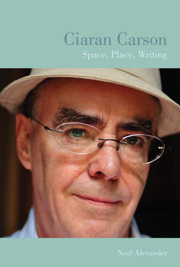Book contents
- Frontmatter
- Contents
- Acknowledgements
- Abbreviations
- Introduction
- Chapter 1 Imaginative Geographies: The Politics and Poetics of Space
- Chapter 2 Mapping Belfast: Urban Cartographies
- Chapter 3 Deviations from the Known Route: Reading, Writing, Walking
- Chapter 4 Revised Versions: Place and Memory
- Chapter 5 Spatial Stories: Narrative and Representation
- Chapter 6 Babel-babble: Language and Translation
- Bibliography
- General Index
- Index of Works
Chapter 5 - Spatial Stories: Narrative and Representation
- Frontmatter
- Contents
- Acknowledgements
- Abbreviations
- Introduction
- Chapter 1 Imaginative Geographies: The Politics and Poetics of Space
- Chapter 2 Mapping Belfast: Urban Cartographies
- Chapter 3 Deviations from the Known Route: Reading, Writing, Walking
- Chapter 4 Revised Versions: Place and Memory
- Chapter 5 Spatial Stories: Narrative and Representation
- Chapter 6 Babel-babble: Language and Translation
- Bibliography
- General Index
- Index of Works
Summary
At the end of Volume VI of The Life and Opinions of Tristram Shandy, Gentleman Laurence Sterne's eponymous author-narrator pauses to review his progress so far, presenting the reader with a series of visual diagrams representing the course taken by his narrative in the preceding volumes. In each of these a series of turns and detours, loops and spirals indicate the various digressions, whimsical flourishes, and redundant elaborations he has made along his meandering and pointedly non-linear way from beginning to middle to end. Moreover, in a characteristically Sternean irony, it is during this digression upon his tendency to digress that Tristram determines to mend his ways and continue with his story ‘in a tolerable straight line’, one ‘turning neither to the right hand or to the left’.
Such deliberate self-contradictions have led Paul Muldoon to regard Tristram Shandy as exemplary of a wider tendency in Irish writing towards the disruption of linearity by way of ‘veerings from, over, and back along a line’ and a related affinity for ‘the notions of di-, trans-, and regression’. To say nothing of Muldoon himself, such tendencies are prominent in the restlessly inventive interest in narrative and storytelling that has been evident in Ciaran Carson's writing at least since the publication of The Irish for No in 1987.
- Type
- Chapter
- Information
- Ciaran CarsonSpace, Place, Writing, pp. 143 - 174Publisher: Liverpool University PressPrint publication year: 2010

